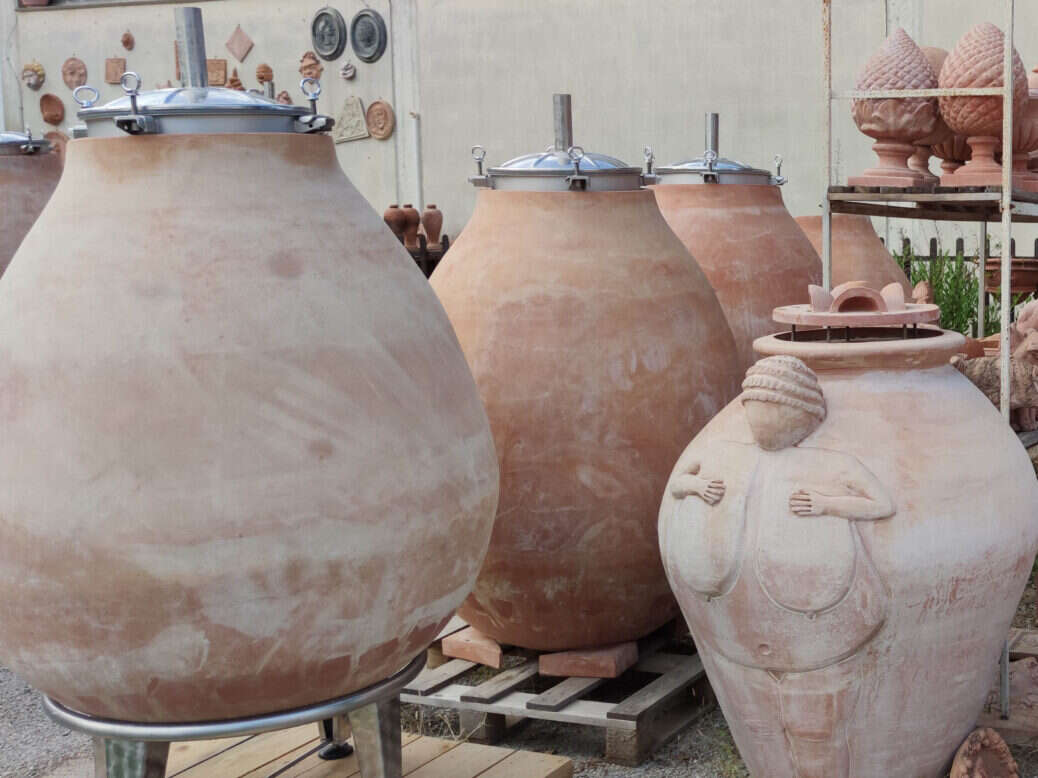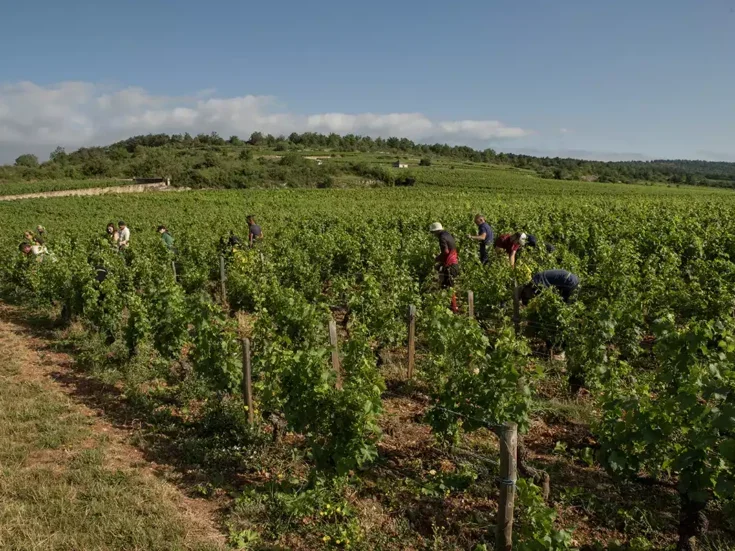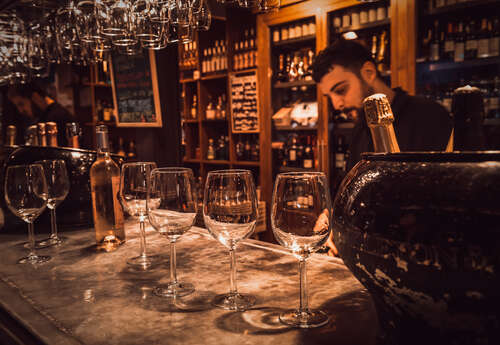
In the first of two reports from the 2022 edition of La Terracotta e il Vino/Terracotta & Wine, the annual Tuscan festival of amphora and other clay-pot winemaking, Paul White celebrates the crucial role played by family firm Artenova in the development of the global amphora winemaking movement.
Back in the early 2000s, Artenova—like the handful of other barely surviving potteries in Impruneta, Tuscany—had been reduced to producing kitschy, Baroque answers to garden gnomes, da Vinci busts, and cheesy statutes of nude women with dreamy-eyed expressions and ambiguously placed hands.
Only just scratching out a living, it was clear there was no future in any of it.
Little known, but absolutely central to the growth of the amphora wine movement globally, this small, family-run pottery factory has single-handedly revived the production of ancient Roman dolium fermentation vessels in modern times.
Based in Impruneta, an historically important pottery town nestled in hill country 10 miles (16km) south of Florence, Leonardo and Andrea Parisi’s small factory has since gone on to dominate modern clay pot production with hundreds of clients scattered across wine regions on six continents.
Equally significant, Artenova has been instrumental in establishing an important bi-annual wine event La Terracotta e il Vino/Terracotta & Wine. This forum has promoted the exploration of clay-pot winemaking, in both ancient and modern times, alongside a fair where producers from all over the world could show their newest wines.
Both have flown under most everyone’s radar for far too long.
The early days of the modern Italian amphora movement
The main problem during the formative period of the Italian amphora movement was a complete lack of large scale, Roman-era clay fermentation pots in which to make wine.
The first wave of revivalists in the early 2000s based around Gravner in northern Italy were unaware that Rome’s dolium tradition had survived continuously through Portugal’s talha pots. Instead, they looked to Georgia’s buried qvevri and their amber wines for guidance.
It was inevitable that others would pursue purer Roman free standing dolium designs and their markedly different wine styles.
And all that, in turn, led back to Impruneta and its unique galestro clay.
Since time immemorial, Impruneta has been to Florence what Cararra’s marble was to the Renaissance. Renowned for its high iron content, tensile strength, and frost-resistant durability, after firing galestro-driven terracotta carries its own signature metallic ring.
Della Robbia used it in his finely sculpted ceramics; tiles, fired in Impruneta’s kilns, still protect Brunelleschi’s Duomo after 700 years of weathering.
Which is where Artenova comes into the picture.
Suddenly in 2008 Artenova’s fortunes took a radical turn.
Leonardo Parisi explains, “We made the first doliums then. Commissioned for a villa restorer from Rome, they were not for wine use, only ornamental. Afterwards, we decided to go back to making them for enological use.”
Terracotta & Wine’s Roxana Edwards elaborates, “Leonardo had no professional experience with wine-oriented pottery, but he was encouraged by his friend Sergio Bettini to have a go.”
Leonardo’s first experimental foray into amphora wines involved a collaboration with vineyard-owning Bettini and winemaker Francesco Bartoletti.
Word got out and a pair of considerably larger producers, Tenuta Belvedere and Castello di Rampolla, ordered wine jars.
From there the business took off. Refocused exclusively on terracotta wine vessels, with brother Andrea committed to full-time pot-making, the firm expanded into a larger factory with a massive electric kiln, ensuring precise and consistent firing temperatures.
Developing the dolium-esque
Taking on winemaker feedback concerned with uncontrolled oxidation, Artenova developed a modern hybrid dolium–esque design in 2014, attaching a stainless steel collar and gasket-sealed cover. This guaranteed air tightness and controlled micro-oxidation only via the pot’s walls.
Other winemakers preferred a pure clay design that led to a clamp-able terracotta cap with sealed fermentation locks. Both are now Artenova’s “signature” pots.
Artenova’s first pure dolium was commissioned by Christophe Caillaud for the Gallo-Romano Museum in Vienne, France. It was a copy to replace the collection’s ancient 1,000-liter (220-gallon) original, which needed to move indoors for preservation.
Premiered at Terracotta & Wine 2014, it was an instant hit, that led to many orders from winemakers.
Other historical and newly conceived shapes followed and eventually a 220-liter (48-gallon) clay egg was developed to keep the bio-dynamicists happy. More stylishly formed, Artenova laid the egg on its side, rather than following the conventional fashion of standing it on its head.
Over time the firm has experimented with a wide variety of sizes and shapes, often pushing the utilitarian into the realms of pure art. Most recently Artenova participated in a project promoted by the Contemporary Art Museum Luigi Pecci (in Prato, Tuscany) that resulted in several stunning combinations of glass and terracotta.
At present, Artenova produces around 300 pots a year, supplying over 140 producers in almost every sub-region of France and Italy.
Beyond that their pots make wine in another 20 countries on 6 continents, from Tunisia to New Zealand, South Africa, and Japan.
Australia’s Trofeo Estate has had more than 140 pots alone since 2016. Brewdog is making beer in Scotland in designated pots and a couple of years ago Artenova supplied pots to make authentic ancient Tuscan beer. 3,400 pots later, Artenova has proven that Impruneta’s clay is here to stay.
Terracotta & Wine: Percolating on its own path
Percolating along on its own parallel path over the last eight years, La Terracotta e il Vino has provided a central rallying point for the global amphora movement to come together every couple of years, to learn more about itself, and to share its wines with consumers.
Launched in 2014 with 30 wineries showing their wares, larger events followed in 2016 and 2018, then, after being stifled by Covid in 2020, it returned again this year in June, meeting for the first time in the magnificent 14th-century La Certosa di Firenze monastery.
Artenova has played an important role in the initial stages of its development and has provided ongoing financial support. As the factory’s success grew both nationally and internationally, Sergio Bettini (also a professional arts event organizer) encouraged the family to grow the movement beyond Tuscany through a forum where information and research could be shared and winemakers could show their wines to both the public and to each other.
A formal cultural association (Associazione Culturale La Terracotta e il Vino) was formed drawing in close friends to help and thereafter La Terracotta e il Vino quickly became a lightning rod for winemakers around the world.
The first event drew in wineries from places as far afield as Australia, Armenia, Georgia, as well as other parts of Europe, with Portugal’s talha showing up in significant numbers for the second instalment.
Suddenly Georgians and Portuguese understood they weren’t alone in their old terracotta wine traditions and that newer advocates were unlocking whole new possibilities for clay-made wine. Similarly, the new kids on the block recognized that techniques that had been worked out thousands of years ago still held true today.
The full potential of amphora
One can’t downplay how important this has been to the movement in understanding itself and its full potential.
Where previously amphora had been a subset of the natural wine movement, suddenly it was freed from these boundaries as a distinctive technology in its own right with even greater potential.
The event has also provided a cutting-edge academic platform to present the latest historic and scientific research, often supported by tutored, comparative wine tastings.
Topics have included antiquarian studies of clay-pot cultures in Georgia, Armenia, Rome, and Portugal; chemistry studies focused on oxygen transfer rates, heavy metals, alcohol, acidity, etc; and comparisons of terracotta’s influence on Sangiovese, Barbera, Cabernet Franc, and other grape varieties versus stainless steel, oak, and concrete containers. Many of these are accessible on La Terracotta e il Vino’s website.
In Part 2 of my coverage of this year’s event, which will be published on worldoffinewine.com next week, I will examine some of this research more closely, while discussing the exhibiting producers, and wines, in more depth.






